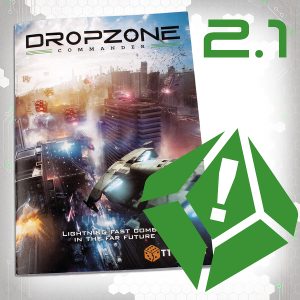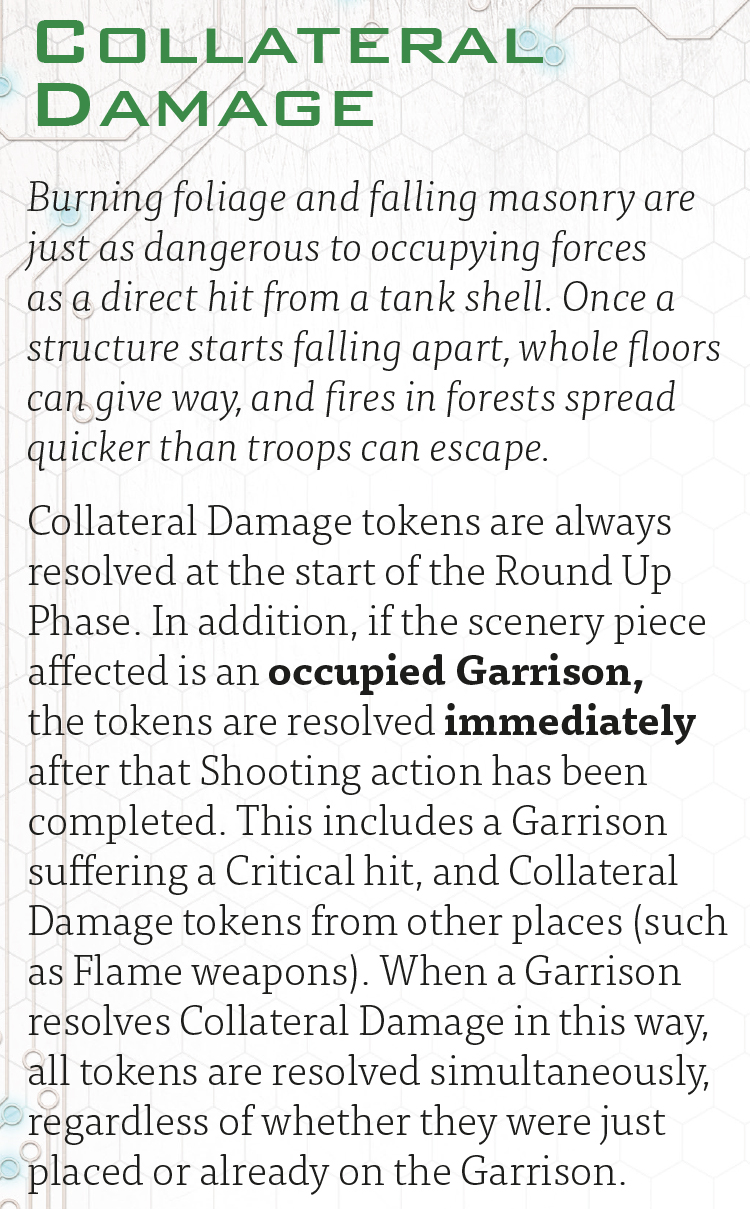Let’s look at some more new rules!
This week we’re taking a peek at some tweaks (that rhymes!) in the new small format Dropzone Commander rulebook.
This new book isn’t a massive change from the last one – in fact anyone with Battle for Earth can happily carry on using those rules if they want. This update streamlines things a bit more and balances the game out for competitive play. It’s not the same sort of jump between V1 and V2, so don’t worry!
Yesterday we had a look at a couple of tweaks to the Reduced special rule, and today we’re turning our gaze to Collateral Damage.
We had a lot of people writing us about Collateral, and a large amount of data was pulled from gaming days and tournaments (Dave attended the London Grand Tournament and Michigan Grand Tournament last year for this exact reason). One of the big take aways was that there was a lot of rolling that didn’t do much damage, and there were lots of niggly rules that changed when Collateral was applied. Basically it was a lot of remembering for little impact on the game.
Now don’t worry, we’re not upping the damage, but we’re doing our best to limit the number of rolls and streamline how the rule takes place. We still want Collateral to be a big thing, particularly as it makes units like Destroyers or Hazard Suits a lot more tempting since they can re-roll Collateral hits!
Collateral Damage has its own section! It was a pain to find before, sorry about that!
First of all, a little change here: Collateral is always resolved immediately if you shoot at an occupied Garrison. That includes extra Collateral from Flame weapons and other sources. No more questioning exactly when it takes place.
Collateral always happens at the end of the round, but if occupied, also takes place immediately.
The bigger change here though is that all Collateral Damage tokens are resolved at the same time, whether they’re left over or just placed. So you don’t have to set certain ones aside, just add them all up and roll them all together!
This makes Collateral Damage a bit more dangerous. It doesn’t up the Energy or anything (good for Sirens!), but means that a Garrison with loads of Collateral Damage tokens is a more dangerous place to be!
This is a big change to Collateral Damage. The tokens always hit the scenery piece, and can also hit the infantry inside too.
So if you have one infantry squad in a Garrison, both will always be hit at the same time. It didn’t make much sense before that if a squad was inside there was a 50% chance the building wasn’t going to fall down.
The biggest thing this changes is that when only one squad is inside a Garrison (which, from our playtesting and observations is around 40-50% of the time) you save an entire dice roll to randomise damage. It seems small, but when this is happening several times in a round it really adds up!
Also a little sentence here to specify that you randomise the entire lot of tokens in one roll – don’t divide each token up, because it takes forever.
And this is the last big change. Collateral Damage stays on if it damages the scenery piece, and is removed if it doesn’t. The infantry inside don’t determine whether the scenery carries on falling apart.
This is one of those ones which was a little janky in regards to realism. If a forest is on fire, it doesn’t care whether anyone inside gets burned, so why should Collateral Damage tokens be dependent on infantry taking damage?
House Rules – WARNING
A little behind the curtain look lastly about how we play in the office. The rules above help to make Collateral much easier to track and make it have a more profound effect on the game while simultaneously removing dice rolls.
However, there’s a way we roll Collateral here in the office that we thought was a little too weird for the book, but I thought I’d mention in because it speeds things up even more!
When rolling Collateral, for each token you roll one dice for the scenery piece, and one dice for the infantry squad hit. However, we like to roll one dice per token and apply the damage to both infantry and scenery! That means much less dice rolling (although using the regular method you just use different coloured dice to speed things up), and it’s easy to keep track of.
If you have an Armour 7 infantry squad in an Armour 10 Garrison, your Collateral rolls damage the infantry on a 3+. If you roll a 6 the Garrison takes damage too and the token stays on. Easy! It’s a bit weird, particularly as it’s the only time you’d be damaging two things with one roll, but we’ve found it’s a nice way to speed up your games.
Alright, that’s Collateral Damage! A few key tweaks there to make the whole process a lot quicker.
The new Dropzone Commander 2.1 rulebook is out later today, and of course we’ll be back then with a post all about the new kits you can pre-order. Stop by then for more!






